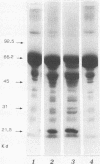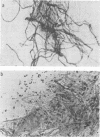Abstract
Candida parapsilosis was isolated from the vaginas of several nonpregnant, nondiabetic, mostly premenopausal outpatients who presented the characteristic signs and symptoms of a frank vulvovaginal candidiasis (heavy discharge with cottage cheese appearance and intense itching, with or without vulvar erythema and dyspareunia). All isolates conformed morphologically, biochemically, and serologically to the standard description of the species. They showed high acid proteinase-secretory activity in vitro and were appreciably pathogenic for cyclophosphamide-immunodepressed mice. Some isolates were also tested for their vaginopathic potential in ovariectomized rats under estradiol administration. In all cases, the rat vagina was colonized by C. parapsilosis to an extent and duration not different from those caused by a vaginopathic isolate of Candida albicans. Periodic acid-Schiff-stained vaginal smears taken at intervals during rat experimental infection showed C. parapsilosis yeasts adhering to exfoliated epithelial cells of rat vagina. Overall, these results emphasize the proteolytic and pathogenic potential of C. parapsilosis and suggest that this fungus may be an agent of clinical vaginitis.
Full text
PDF





Images in this article
Selected References
These references are in PubMed. This may not be the complete list of references from this article.
- Bistoni F., Vecchiarelli A., Cenci E., Sbaraglia G., Perito S., Cassone A. A comparison of experimental pathogenicity of Candida species in cyclophosphamide-immunodepressed mice. Sabouraudia. 1984;22(5):409–418. doi: 10.1080/00362178485380661. [DOI] [PubMed] [Google Scholar]
- Cassone A., De Bernardis F., Mondello F., Ceddia T., Agatensi L. Evidence for a correlation between proteinase secretion and vulvovaginal candidosis. J Infect Dis. 1987 Nov;156(5):777–783. doi: 10.1093/infdis/156.5.777. [DOI] [PubMed] [Google Scholar]
- Cassone A., Torosantucci A., Boccanera M., Pellegrini G., Palma C., Malavasi F. Production and characterisation of a monoclonal antibody to a cell-surface, glucomannoprotein constituent of Candida albicans and other pathogenic Candida species. J Med Microbiol. 1988 Dec;27(4):233–238. doi: 10.1099/00222615-27-4-233. [DOI] [PubMed] [Google Scholar]
- Ghannoum M., Abu Elteen K. Correlative relationship between proteinase production, adherence and pathogenicity of various strains of Candida albicans. J Med Vet Mycol. 1986 Oct;24(5):407–413. doi: 10.1080/02681218680000621. [DOI] [PubMed] [Google Scholar]
- Hurley R., Stanley V. C., Leask B. G., De Louvois J. Microflora of the vagina during pregnancy. Soc Appl Bacteriol Symp Ser. 1974;3(0):155–185. [PubMed] [Google Scholar]
- Kinsman O. S., Collard A. E. Hormonal factors in vaginal candidiasis in rats. Infect Immun. 1986 Sep;53(3):498–504. doi: 10.1128/iai.53.3.498-504.1986. [DOI] [PMC free article] [PubMed] [Google Scholar]
- Kwon-Chung K. J., Lehman D., Good C., Magee P. T. Genetic evidence for role of extracellular proteinase in virulence of Candida albicans. Infect Immun. 1985 Sep;49(3):571–575. doi: 10.1128/iai.49.3.571-575.1985. [DOI] [PMC free article] [PubMed] [Google Scholar]
- McCormack W. M., Starko K. M., Zinner S. H. Symptoms associated with vaginal colonization with yeast. Am J Obstet Gynecol. 1988 Jan;158(1):31–33. doi: 10.1016/0002-9378(88)90770-3. [DOI] [PubMed] [Google Scholar]
- Odds F. C. Candida infections: an overview. Crit Rev Microbiol. 1987;15(1):1–5. doi: 10.3109/10408418709104444. [DOI] [PubMed] [Google Scholar]
- Odds F. C., Webster C. E., Mayuranathan P., Simmons P. D. Candida concentrations in the vagina and their association with signs and symptoms of vaginal candidosis. J Med Vet Mycol. 1988;26(5):277–283. doi: 10.1080/02681218880000391. [DOI] [PubMed] [Google Scholar]
- Rüchel R., Böning B., Borg M. Characterization of a secretory proteinase of Candida parapsilosis and evidence for the absence of the enzyme during infection in vitro. Infect Immun. 1986 Aug;53(2):411–419. doi: 10.1128/iai.53.2.411-419.1986. [DOI] [PMC free article] [PubMed] [Google Scholar]
- Rüchel R., Uhlemann K., Böning B. Secretion of acid proteinases by different species of the genus Candida. Zentralbl Bakteriol Mikrobiol Hyg A. 1983 Nov;255(4):537–548. [PubMed] [Google Scholar]
- Sobel J. D. Epidemiology and pathogenesis of recurrent vulvovaginal candidiasis. Am J Obstet Gynecol. 1985 Aug 1;152(7 Pt 2):924–935. doi: 10.1016/s0002-9378(85)80003-x. [DOI] [PubMed] [Google Scholar]
- Sweet R. L. Importance of differential diagnosis in acute vaginitis. Am J Obstet Gynecol. 1985 Aug 1;152(7 Pt 2):921–923. doi: 10.1016/s0002-9378(85)80002-8. [DOI] [PubMed] [Google Scholar]
- Witkin S. S., Hirsch J., Ledger W. J. A macrophage defect in women with recurrent Candida vaginitis and its reversal in vitro by prostaglandin inhibitors. Am J Obstet Gynecol. 1986 Oct;155(4):790–795. doi: 10.1016/s0002-9378(86)80022-9. [DOI] [PubMed] [Google Scholar]




